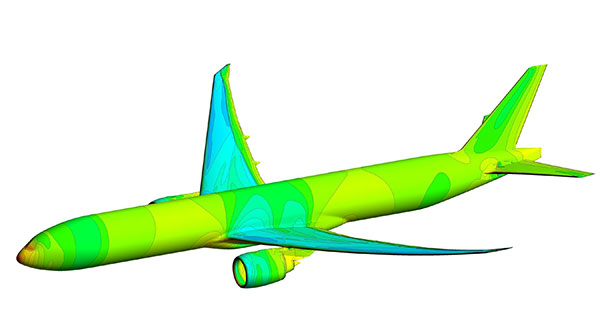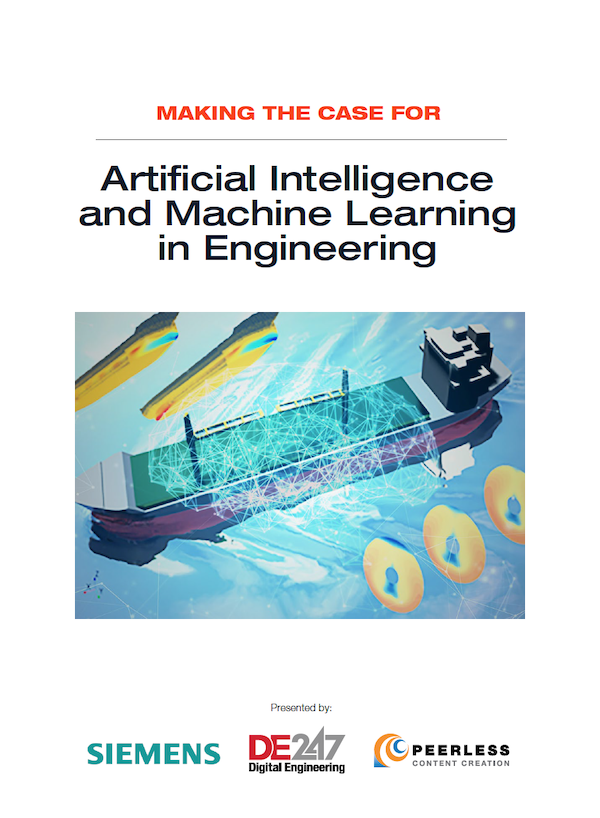Lufthansa Technik Uses Ansys Technology
Partnership enables Lufthansa to develop and certify AeroSHARK technology for more sustainable aviation, companies report.

Using Ansys CFX, Lufthansa Technik created a CFD model of the Boeing 777-300ER including realistic wing shape. This helped determine the pressure distribution and corresponding forces and moments which act on the aircraft. Image courtesy of Ansys.
Latest News
June 8, 2023
Lufthansa Technik, provider of technical aircraft services, integrates Ansys' simulation solutions to design and certify AeroSHARK, a biomimetic coating technology that emulates shark skin and is said to reduce fuel consumption and carbon dioxide (CO2) emissions.
By leveraging Ansys' computational fluid dynamics (CFD) and high-performance computing (HPC) technology, Lufthansa Technik and BASF, a chemical company, designed the coating film with a ribbed texture consisting of small elevations referred to as riblets. The riblet effect imitates the placoid scales on shark skin, which help sharks cut through water by reducing drag and friction while increasing buoyancy. Engineers used Ansys' CFD to analyze turbulent flow phenomena surrounding the riblets to help ensure they would generate the same effect, the companies report.
Lufthansa Technik used Ansys' tools to build and validate smaller, more generic virtual prototypes of AeroSHARK before scaling and tailoring the prototypes through aerodynamic simulations. With ability to simulate the aircraft, including in-flight behavior, and verify the riblet effect using turbulence modeling, Lufthansa Technik reduced the risk of physical flight tests and reduced the time to certification, the companies report.
AeroSHARK is certified by the European Union Aviation Safety Agency (EASA) and the American Federal Aviation Authority (FAA) for two types of Boeing 777s and is currently operating in flight by Swiss International Air Lines (SWISS) and Lufthansa Cargo. Once all 11 Boeing 777Fs at Lufthansa Cargo and all 12 777-300ERs at SWISS have received their AeroSHARK modification, they will reduce the Lufthansa Group's carbon footprint by more than 25,000 tons annually.
“AeroSHARK can significantly contribute to more sustainable air transport,” says Stefan Kuntzagk, senior engineer, aircraft performance, CFD, and flight test at Lufthansa Technik. “With the ability to model aircraft and aerodynamic behavior in a predictively accurate, robust, and computationally efficient manner by using Ansys' simulation solutions, we can enhance and expand our shark-inspired technology to make entire subfleets more climate-friendly, reduce fuel consumption, and decrease CO₂ emissions for commercial aircraft.”
“We are constantly amazed by the creativity of our customers, and Lufthansa Technik has elicited the same reaction with its trailblazing AeroSHARK coating technology, which has the potential to significantly reduce fuel consumption and CO2 emissions,” says Walt Hearn, senior vice president of worldwide sales and customer excellence at Ansys. “Our customers continue to demonstrate what is possible when Ansys' simulation solutions are combined with ingenuity and vision. As more sustainable propulsion systems are still being researched and tested, innovations like AeroSHARK are pivotal in the immediate reduction of aviation's carbon footprint.”
Sources: Press materials received from the company and additional information gleaned from the company’s website.
More Ansys Coverage
Subscribe to our FREE magazine, FREE email newsletters or both!
Latest News
About the Author
DE’s editors contribute news and new product announcements to Digital Engineering.
Press releases may be sent to them via DE-Editors@digitaleng.news.






